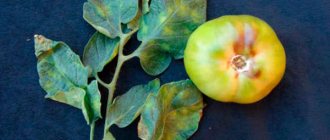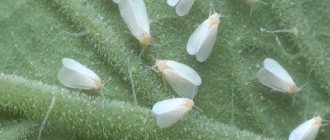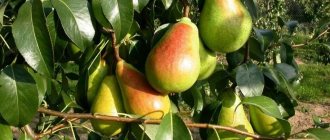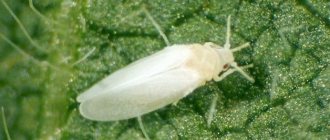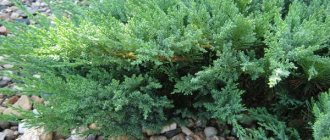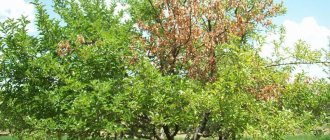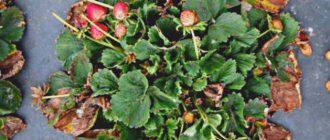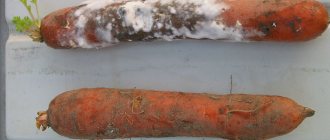Strawberry brown spot disease or marsoniosis is considered the most insidious disease of the berry crop. The causative agent of the disease is the fungus Marssonina petontillae. The peak of the disease occurs during the fruiting period. It is at this time that you can notice brown strawberries in the garden bed, infected with brown spot.
The spread of brown spot disease is facilitated by increased soil moisture during periods of prolonged rain, so brown spot on strawberries can appear at any period of its vegetative growth.
Ramulariasis
The causative agent of the disease is a fungus – Ramularia. The disease begins with the appearance of small red-brown spots on the leaves. They begin to grow and become white in the center, then the white part falls off and the leaves become perforated. From the leaves, the disease spreads to the stems and peduncles of strawberries, then spreads to the root system, as a result of which the bush dies.
The peak of the disease occurs during the flowering period of strawberries, usually May-June. Spores are carried by wind and insects. The cause of the development of the disease is high humidity, high ambient temperature, and too close proximity of strawberry bushes to each other. The danger lies in the fact that this fungus tolerates cold well and survives the winter. It affects crops not only in open ground, but also in greenhouses.
Ramulariasis is completely curable, the main thing is to start treatment on time. Otherwise, the disease can quickly destroy the plants. In most cases, infected strawberries can be saved using effective chemical treatments. If the roots are not affected, first of all you need to pick off the diseased leaves and fruits. If the root system is affected, it is useless to treat the bush; it must be destroyed: it must be burned to prevent infection of healthy plants.
What to do:
- Spray the bushes with Bordeaux mixture 1% or cuproxate before flowering and after picking the berries. An effective remedy for treating plants against fungus is Ridomil, from which a solution is prepared (25 g of powder per 10 liters of water).
- Regularly thin out plantings to avoid overcrowding;
- Choose varieties that are resistant to the disease;
- It is reasonable to approach soil fertilization with mineral mixtures.
Strawberry leaf affected by ramularia
Traditional recipes for brown spot
Folk remedies are usually used only for the purpose of preventing the disease, because when symptoms of brown spot appear, there is no use in treating with these drugs.
Brown leaf spot - video
Vegetable plants, in order to prevent cladosporiosis, are treated with a solution of whey or fermented milk. Milk protein inhibits the development of fungi, but is not able to destroy them completely. The working fluid is prepared as follows:
1 liter of whey and 1 tsp are dissolved in a bucket of water.
hydrogen peroxide. Prepare a 1% solution of farmiod and spray the crops before flowering and a week after it. This treatment prevents the development of brown spot.
Brown spot
This is a fungal disease. Brown spots first appear along the edges of older leaves. They have a tendency to grow over the entire area of the leaf plate. Darker areas with fungal spores form on the spots.
Affected bushes must be dug up and burned to prevent the disease from spreading throughout the area. The cause of the disease is high humidity, thickening of plantings, and lack of sunlight. To treat brown spot on strawberry leaves, the remaining bushes are sprayed with 1% Bordeaux mixture. Reduce watering and eliminate nitrogen fertilizers. After harvesting, strawberries are treated with Fitosporin.
To prevent the disease it is necessary:
- removing last year's dry leaves on overwintered bushes;
- extermination of insect pests;
- mulching the soil with straw and ash.
Strawberry brown spot
Reasons for appearance
The fungus is activated in conditions of high humidity. Rainy summers and errors in watering schedules provoke the development of the pathogen, and if measures are not taken, the disease will become widespread.
Also, the causes of brown spotting are:
- lack of planned changes in strawberry beds. For many gardeners, crops grow in one place for a long time, while an infectious background accumulates in the soil. The lack of crop rotation (and not only for strawberries) leads to frequent outbreaks of diseases and reduced yields;
- violations of the rules of agricultural technology: thickening of plantings, plant residues on the beds after weeding. In such conditions, the fungus feels at ease, and the disease progresses;
- errors in crop nutrition. Excess nitrogen is one of the main causes of marsoniosis, while plants are deficient in potassium, phosphorus, and microelements;
- infection through insects.
Leaf rust
This fungal disease appears in the spring. It is characterized by yellow spotting, which darkens over time, acquiring the color of rust. Red spots grow over the entire surface of the leaf, becoming voluminous, resembling rust-colored mold. The leaves and stems dry out, and the crop yield decreases. If measures are not taken, the affected bush will die, and the fungus will spread to other plants.
If you find a plant with rust, you need to put on gloves, lay a polyethylene film under the bush, cut off all the affected leaves at the root and burn them away from the garden plantings. Under no circumstances should they be thrown away or buried: the fungus thrives in the ground in winter and infects plants again in the spring. After pruning, it is necessary to treat the strawberries with Bordeaux mixture (maximum concentration of 1%) or with products such as Agrolekar or Titan. As for fungicides that are effective in combating fungus, they may contain substances harmful to humans, for example, mercury, copper.
Rules for treating strawberry stains
Garden strawberries (this is the official name of strawberries) require constant care. A special place in agricultural technology is occupied by the treatment of diseases and pest control of berry bushes. Only a crop that is given time has excellent fruiting.
General rules for the treatment of diseases and pest control consist of the following points:
- As soon as the snow melts and the soil begins to warm up, the gardener waters the garden bed with water whose temperature is at least 55 degrees. Boiling water helps get rid of pests and bacteria.
- It is recommended to prepare a hot solution of manganese. This way the soil will be better disinfected. Treatment with a hot solution of copper sulfate is allowed. The product in an amount of 10 grams is dissolved in a 10-liter bucket of boiling water.
- You can do without boiling water. Then the strawberry bed is watered with Bordeaux mixture (3%).
The foliage turns red
If the leaves of a crop suddenly begin to turn red in spring or summer, there may be several reasons:
- The berry plant lacks nutrients;
- The soil is too acidic;
- A fungus settled on the plant, which led to brown spotting.
The foliage may turn red due to increased acidity of the soil. The culture develops normally only in soil whose pH is 6-6.5 pH. Such soil is considered slightly acidic, neutral. To reduce the acidity of the soil, dolomite flour and ash are embedded in it. Approximately one glass per square meter.
Red leaves on strawberries:
- Dried or damaged leaves are removed throughout the season.
- Fragrant plants are planted next to the strawberries. Among the popular ones: marigolds, calendula. They will repel pests.
- Diseases are treated with different drugs. For example, wilting can be defeated with the biological product Trichoderma verde. Fruit rot will go away if you transplant the strawberries away from the area with raspberries, spray them before flowering begins, either with an infusion of ash, or an infusion of mustard with garlic, or with the biological fungicide Alirin B.
- When a transparent mite invades, the crop is treated with high temperatures. On a very hot day, the entire strawberry plot is covered with film. A thermometer is placed there. As soon as it reaches +60 degrees, the film can be removed. Next, each bush is cut off, leaving only a small petiole. The leaves are burned.
Aphids, leaf rollers, thrips, and leaf beetles are fought with the help of ash infusion. Alatar is also effective.
Brown spots
If your strawberries have brown spots at the end of summer, then the plant may have developed corner spot. Other names for the disease: brown spot, bacterial wilt. It differs from brown, both in its characteristics and in the time of its appearance. Brown spotting occurs at the beginning of the season, and angular spotting occurs at the end. It is because of this that summer residents do not take the disease seriously, believing that the leaves have changed color due to the approach of autumn.
Corner spot appears on the leaves as brown spots that show through when you look through them into the light. The lower part of the leaf blade may release light moisture in damaged areas.
A dark border can be seen on the bottom of the leaf. Why and how does the disease occur? Its causative agent is the bacterium X. Fragariae. She loves water. Develops in high humidity. It can penetrate into the plant through open areas, fractures, and wounds. In autumn, leaves affected by the bacteria may dry out. The pathogen overwinters on them.
If brown spots appear on strawberries, how to treat them? First you need to remove all diseased bushes and weeds. As soon as young foliage begins to grow, it should be treated with copper oxychlorate. The disease may disappear after treatment with strong fungicides, including: Skor, Ridomil Gold, etc.
If the leaves begin to turn yellow in spring or summer, and then quietly dry out, this may be chlorosis. It is recommended to fight it with iron sulfate diluted in water. Also suitable drugs are Ferovit and Helatin.
Strawberry leaf edges are brown
If the edges of the strawberry leaves change color to dark, turn brown, they dry out. The edge, and then the whole plate can dry out due to pests. There is a high probability of whitefly, strawberry leaf beetle, and weevil appearing on the plantation. The insects drink the sap of the plant, leaving him exhausted. This state of affairs negatively affects the harvest.
Pest control involves the use of insecticides.
Suitable ones include:
- Fufanon;
- Intavir;
- Karbofos;
- Rovikurt;
- Aktara;
- Confidor, etc.
The products are used according to the instructions.
A popular way to remove harmful guests is to prepare a soap-ash solution. A whole piece of laundry soap is diluted in a bucket of water. Several glasses of ash are added there. Everything gets mixed up. Bushes are sprayed with this medicine.
The edges of the leaves turn brown due to lack of proper watering. To ensure that the crop has enough water, it should be watered once every 3-5 days. If the weather is hot, watering should be done more often. A gardener can tell if a strawberry needs water by looking at the dry soil under the bush.
Red spots
If a red string of spots appears on the leaves, it may be red spot. The disease is dangerous. It leads to the death of the plant. The fungus manifests itself as small reddish-brown spots on the leaf plate. Or a dot appears first. Then the red spot and dot grow. The leaf turns completely red.
The gardener must remove all damaged leaves, thin out the bed, and weed it. It should be well ventilated. Next, it is supposed to be treated with fungicides, among the popular ones: Ridomil, Skor, Topaz. Copper-based products help in the fight against red spotting.
Rust spots
One of the common diseases of garden strawberries is rust. Its first sign is spots on the foliage. Their color is similar to rusty, dark carrot. The spots take the form of swellings. Fungal disease easily passes from one plant to another. The leaves begin to rust on all the bushes in the garden.
To get rid of the disease, the crop is treated with Forecast and Baktofit.
Dark spots on leaves
Another disease that is clearly visible on the leaves is white spot. Its signs are small dark spots. At first their size is about 1 mm. Then they begin to grow. Gradually increasing, the center of the spot turns whitish. A barely noticeable coating appears on it. The fungus that causes white spotting penetrates from the leaves to the stems and flowers. If measures are not taken in time, the leaves become severely depleted and holes form on them. As a result, the plant dies.
Experienced gardeners spray bushes with Falcon, Zineb, and Bordeaux mixture. It is important that both sides of the sheet are processed.
Burgundy stains
If peculiar burgundy-colored indentations appear on the leaf blade of garden strawberries, it means that the plant has been overcome by anthracnose. This is a disease that is also caused by a fungus. The attack goes not only on the leaves, but also on the entire ground part of the bush. Burgundy spots are quite noticeable on the runners, petioles, and fruits. As a result, the fruits rot and dry out. The whole bush dries up.
Suitable drugs for killing fungus:
- Cumulus;
- Antracol;
- Metaxyl.
Lack of nitrogen in the soil
Typically, reddening of the foliage indicates nitrogen starvation. In this case, it is worth feeding the plant with nitroammophoska (another name for azofoska), ammonium nitrate.
Azofoska is applied in spring and summer. The month of June will do. It is allowed to embed granules into the soil or dissolve them in water. If the first method is chosen, then 25-35 grams should be scattered per square meter of soil. facilities. Afterwards the garden bed is watered. You can dissolve a matchbox of nitroammophoska granules in a 10-liter bucket of water.
The right time for ammonium nitrate is the first half of the season. It is scattered into shallow trenches between the bushes. Dosage – 10 g. per one square meter.
Another reason for sudden reddening of leaves is a lack of phosphorus. In this case, superphosphate is added. They can treat the bed three times per season. The fertilizer interacts well with organic matter. 35 gr. superphosphate is mixed with a glass of fly ash and a solution of cow manure. Cow dung solution is prepared from 7 liters of water and 1 liter of manure. Such fertilizing will not only provide the crop with phosphorus, but will also make the fruits much sweeter.
Anthracnose
This disease is also called black spot and is characterized by the appearance of multiple brown spots on the leaves. As the disease progresses, they merge and turn from red-brown to black. The whiskers and petioles become covered with sores. Anthracnose often appears in greenhouses. The causative agent is the fungus Colletotrichum acutatum Simmonds. Leaves, shoots, flowers, roots are affected, and the berries dry out. If urgent measures are not taken at an early stage, the plant will die.
The pathogen does not tolerate temperatures above +32 degrees, but feels great in the area from +25 to +28 degrees and relative humidity from 95 to 100%. In general, it tolerates unfavorable external conditions well.
At the first signs of infection, plants are sprayed with a fungicide - Signum, Metaxil (put 40-50 g of product per 10 liters of water). If only the leaves are affected, the bush can be saved. If the fungus has infected the main trunk and shoots, then the plant must be removed from the soil and burned, and neighboring healthy bushes should be sprayed for prevention with a solution of Metaxyl or Signum (25 g of product per 10 liters of water).
Anthracnose is rare in Russia; it is mainly imported with infected seedlings from Europe
Angular or brown spotting
Around mid-summer, strawberries become infected with Dendrophoma obscurans. The fungus invades strawberry leaves, causing them to become covered with reddish or brown spots. The tissue along the edge of the foliage gradually dies off, the plant withers and dies.
Spraying with copper-containing preparations at the beginning of the growing season and following the rules of crop care help prevent brown or corner spotting.
There is no treatment; the affected bushes are dug up and burned along with the roots.
What to do
The causative agent, the fungus Marssonina potentillae, parasitizes the leaves of the plant. Reddish-brown spots appear on the surface, which gradually grow and become covered with black mycelial spores.
Infected bushes dry out and die. The disease is sluggish, activity is usually visible in early summer, then, when new foliage appears, the infection subsides. Without treatment, berry plantations are at risk of being completely destroyed.
What to do:
- cut off or completely remove diseased plants from the beds;
- treat plantings with biofungicides;
- disinfect soil and garden tools;
- mulch the soil in the rows;
- add potassium and phosphorus additives.
After picking the berries, it is recommended to treat the plantings with Fitosporin.
How to Treat Brown Spots on Strawberries
What to do if a problem is detected:
- Remove affected leaves;
- Be sure to treat the plant with special preparations: “Metaxil”, “Signum”, “Anthracol”.
To process strawberries, you can use the drug Metaxil.
The plant can be saved only at the initial stage of the disease, when only the leaves are affected. If spots appear on inflorescences or fruits, it is better to get rid of this strawberry bush.
Caused by a fungus called Dendrophoma obscurans (Ell. et Ev.) Anders. It can develop most actively from July to September. Signs:
- The appearance of red-brown spots on old leaves;
- The edges of the leaves turn brown and die.
Protection measures include spring cleaning of the beds from old leaves and spraying with a 3% solution of Bordeaux mixture.
Fungicides
Traditional remedies popular among summer residents help only in preventing infection, as well as in the early stages of marsoniosis. But most often, the disease is noticed already at the height of the epidemic, when the spots have covered large areas of plant tissue, and herbal infusions will be ineffective against the pathogen.
Fungicidal preparations of contact and systemic action are used, alternating formulations and following the recommendations for use. Each fungicide has its own timing of application, but usually treatment with chemicals is not carried out during flowering and fruiting. From the moment of treatment, more than 30 (and for some preparations even more) days must pass before the berries ripen and are harvested.
On a note! Consider the compatibility of the products with each other, as well as the ambient temperature. When applied in the spring, when it is cool, some fungicides may not give the expected result.
Preparations against brown leaf spot (in case of mass infection):
- Fundazol;
- Falcon;
- Ordan;
- Ridomil Gold;
- Speed
The fungicide Oxychom has proven itself well, and for spring treatments they use copper oxychloride and Bordeaux mixture (1%).
Infected bushes are removed from the ridge and burned. Soil disinfection is required, as the pathogen spreads quickly in the ground. Soil treatment with Fitosporin and planting green manure in the old place are effective.
Folk remedies
Strawberries are treated using folk remedies:
- potassium permanganate solution (5 grams of the drug are diluted in a bucket, and the plantings are spilled);
- infusion of wood ash (while feeding the plants with potassium);
- soda solution with iodine (take 15-20 grams of baking soda and half a bottle of iodine per bucket of water).
Often, gardeners mow down strawberries after harvesting, hoping that this will get rid of the harmful fungus. But such control measures do not save strawberry brown spot, since the pathogen persists in the soil and plant debris. The optimal solution is to purchase new planting material. Old plants are used only when you are sure that all the bushes are absolutely healthy.
Prevention
Don't forget about preventive measures. In spring, you can treat the bushes with Bordeaux mixture (3% concentration). You can also use the preparations “Jet” and “Cumulus”.
Cumulus is one of the means used for prevention.
When viruses, fungi or insects have already become active, crop losses cannot be avoided. To prevent losses, preventive measures are needed.
General measures to prevent diseases and pests:
- Timely weeding and destruction of weeds. Clearing up plant debris at the end of the season and pruning leaves in the fall. Weeds and old leaves may contain insects, fungal spores, and bacteria.
- Maintaining crop rotation. Change of site every three years. Prohibition on planting after unfavorable predecessors - potatoes, tomatoes, pumpkins.
- Purchasing planting material from trusted suppliers. Often, unscrupulous sellers give away strawberries that are already contaminated with something.
- Compliance with the norm and frequency of watering, timely application of fertilizing - ash, mullein solution, complex mineral fertilizers.
The most effective protection of strawberry beds from most diseases and pests are preventive measures, including compliance with agricultural practices and timely spraying. If you do not take care of protecting berry plantations, there is a risk of losing the harvest completely.
Fusarium
A disease caused by fungi of the genus Fusarium, transmitted through roots. A sign of infection is the appearance of brown spots on the leaves. The shoots turn brown, the leaves curl, and the ovary does not form. The roots gradually die off, the rosettes dry out, and the plant withers. If urgent measures are not taken, the fungus can destroy up to 80% of the entire strawberry crop.
At the initial stage, the disease can be stopped. What can you do for this:
- Spray the plant with a fungicide, for example Fitosporin.
- Choose seedlings carefully; all plants should be without the slightest sign of fungal attack;
- You cannot plant strawberries in beds where potatoes or tomatoes were previously cultivated;
- Weed out weeds, remove old leaves and tendrils, avoiding thickening of the plantings.
Fusarium also affects tomatoes and potatoes, so strawberries or wild strawberries should not be planted in beds where these crops were previously grown. Fungi produce mycotoxins that adversely affect the human nervous system and contribute to the death of animals.
Fusarium wilt of strawberries
Verticillium wilt of strawberries
This fungal disease is caused by the pathogens Verticillium albo-atrum Reinke et Berthold and V. dahliae Kleban. The roots, vascular system, and root collar of plants suffer. Infection occurs through soil, tools, weeds and fungus-affected vegetables. Signs of pathology:
- dark spots appear on the whiskers and petioles;
- the leaves turn red-yellow and then brown;
- new leaves and tendrils do not grow;
- the bush withers and dies.
Verticillium wilt of strawberries
If the problem is ignored, you can lose up to 50% of the harvest. Infected bushes are immediately removed and destroyed. Prevention of the disease:
- purchasing strawberry varieties resistant to fungal diseases;
- treatment of roots before planting with Humate K;
- correct crop rotation;
- planting grain crops, alfalfa, and marigolds next to strawberries;
- treatment of plants with fungicides Fundazol, Benorad.
Red spots on strawberry leaves
The cause of the disease is a fungus from the genus Marssonina petontillae. Small spots first appear on the lower leaves of the strawberry, then they grow, acquiring a dark red color. On the spots you can see dark dots containing spores. If most of the leaves are covered with red spots, the bush cannot be saved; it will die. It needs to be dug up and burned. Treat nearby healthy plants with such products as Falcon, Oksikhom.
You should not try to save hopeless plants; it is better to get rid of them as quickly as possible, otherwise there is a risk of infecting other bushes.
The reproduction of the pathogen is provoked by high humidity in the area and unkempt strawberry beds. For prevention, in early spring, as soon as the snow has melted, strawberry bushes are treated with a solution of Bordeaux mixture. This fungus prefers to overwinter in fallen leaves and with the onset of spring begins to infect strawberry bushes. It is important in the autumn before the onset of winter to thoroughly clear the area of leaves.
In addition to infection, the cause of red strawberry leaves may be a lack of phosphorus or acidified soil. To prevent fungal infection, it is useful to spray strawberry beds with a solution of wood ash or garlic infusion.
Rules for wrestling
Regardless of the method by which the gardener decides to fight the disease, one should adhere to the general rules:
- Control of planting density of bushes . As soon as they begin to grow strongly, it is necessary to replant the plants.
- Timely removal of weeds .
- The area must be clean . Dry leaves should not be allowed near green strawberry bushes.
- Compliance with watering rules . Do not water strawberries with cold water. Its temperature should be as close as possible to the soil temperature.
Watering with cold water is harmful to strawberries.
General methods of controlling fungi
- All affected bushes must be ruthlessly destroyed to prevent infection of healthy ones.
- Get rid of high humidity in areas with strawberries.
- Sanitize the beds. Feed plants not with nitrogen, but with potassium and phosphorus fertilizers.
- When foliage grows, before flowering and after harvesting, treat strawberries with Bordeaux mixture.
- If the spotting does not appear on single bushes, but has become widespread, you need to apply fungicides, treating both the upper and lower parts of the leaves.
Black rot on fruits
Black rot on strawberries
Only affects the berries. They become brown, covered first with a gray coating, and then with black fungal mycelium. The fruits secrete juice, become watery, lose taste and smell. The disease develops from damage by insects and slugs. Particularly active in humid, hot weather.
Black rot on fruits cannot be treated. Infected strawberries are dug up and burned. Measures to prevent fungal disease:
- planting healthy seedlings;
- planting seedlings on raised beds (15-40 cm);
- soil disinfection with a solution of potassium permanganate (2 g/10 l of water);
- reduction of nitrogen and organic fertilizing.
Prevention
To prevent spotting, you must follow the following rules:
- Breed disease-resistant strawberry varieties and use healthy seedlings.
- Create beds in dry, open areas. Plant the crop in high and vertical beds, where excess moisture will not accumulate.
- Do not make plantings too dense.
- Weed all weeds and carefully remove the remains of diseased plants.
- When feeding, it is necessary to strictly adhere to the norms so that there is no high concentration of nitrogen. Fungi grow quickly in such conditions.
- Control pests that carry spores.
- Maintain crop rotation. If strawberries have been infected with a fungus, you can plant them in their old place only after 5 years. Plant it in the places where beans, carrots, and garlic were located, but not cucumbers, tomatoes, corn, potatoes, or eggplants.
- Treat the crop with products containing copper.
- Do not plant strawberries in fresh bird droppings or cow manure; it is better to use rotted ones.
Choosing healthy seedlings, following agricultural practices and regular inspection of strawberry bushes will prevent the appearance of spots on strawberry leaves or get rid of the disease at an early stage.
How it manifests itself
Brown spot most often appears at the end of the fruiting period. The peak reproduction activity of this pathogenic fungus occurs in August, September, and October. The disease usually affects about 60% of the leaves, which subsequently fall off. If the season is rainy, the disease progresses very quickly. The ambient temperature at which the fungus is viable must be above zero. When frosty days arrive, Marssonina petontillae goes into a dormant state to become active in the spring.
A bush affected by brown spot is unable to continue growing due to impaired photosynthesis.
The following drugs are good in the fight against brown spot: Skor (efficacy against spotting 85-95%), Topsin-M (65-70%). One treatment is carried out before flowering and 2 treatments after fruiting.
Reasons for appearance
Despite the fact that the brown spot fungus spreads easily, there are practically no obstacles in weather favorable for the parasite; opposite trends can be observed in neighboring areas:
- For some summer residents, the disease rapidly creeps from garden bed to garden bed;
- literally behind the fence the bushes are green and clean.
This is due to the fact that compliance with the requirements of agricultural technology increases the resistance of the crop. And ignoring the rules of planting and care is a risk factor.
Brown spot is more likely to settle on strawberries that:
- Planted too densely. The fungus is activated in a humid environment. If strawberry bushes form a dense carpet, then under the foliage a microclimate is maintained that is suitable for the causative agent of brown spot.
- Watered too often and abundantly. The result is the same - dampness, in which the fungus is comfortable.
- Rarely weeded and loosened. Weeds increase overall humidity levels. Dense soil under thickets of strawberries and wild plants prevents the rapid evaporation of excess moisture.
- Planted in an inappropriate place - in a lowland. Rain is common in the second half of summer. If the site for strawberries is chosen correctly - on a hill, then rainwater, even during flooding seasons, flows downhill and goes into the soil more easily and quickly. Danger of disease
Fungal diseases are more likely to affect those areas where preventive treatments are not carried out in the spring and autumn or at least once a season.
What strawberry diseases are fungicides effective against?
The main diseases of strawberry crops are:
- gray and white rot;
- root rot;
- powdery mildew;
- brown and black spotting;
- anthracnose;
- Fusarium
The exact name of the disease or pathogen is not easy to find out even for experienced gardeners. Therefore, to obtain a good harvest, it is advisable to use broad-spectrum fungicides that eliminate the causative agents of all fungal infections.
Leaves turn yellow and dry out
There is no cause for concern if the leaves begin to turn yellow at the end of the season because this is their biological cycle. But if the problem appears in the spring or at the height of summer, you need to act urgently.
- If watered incorrectly, strawberry leaves dry out on hot days or turn yellow and rot on days that are too wet;
— Strawberry leaves turn yellow, wither and wither due to fusarium. The fungus can completely destroy a plant in about a month and a half;
— Strawberry leaves dry out when affected by gray rot, which most often appears during fruiting. In just a couple of days, the berries become covered with gray moldy fluff;
— With a lack of iron or magnesium, the leaves turn yellow and dry out from the tips. Sometimes the problem is a deficiency of zinc or manganese, but this is difficult to determine precisely, so it is always recommended to use complex fertilizers;
— On too hot days, strawberry leaves may also begin to dry out. To avoid accidentally flooding the plantation, we recommend that you consider shelter and shade;
— If there is not enough sun, the leaves will turn yellow in the same way, because the process of photosynthesis directly depends on the amount of light;
— When all the conditions are absolutely in order, but the leaves still wither along with the shoots, perhaps this is verticillium wilt;
— Chaotic yellow spots, strokes and stripes that intertwine into complex patterns are a symptom of an incurable viral mosaic.
Photo: pro-klubniku.ru
Strawberry diseases: descriptions with photos and methods of treatment
Pale and light leaves
Old leaves may lighten because the plant's resources are spent on crops and young shoots. But if the problem is widespread and unexpected, something is definitely going wrong!
— The leaves weaken and fade if the strawberries do not have enough sun or the planting is too thick;
— At the stage of active growth of green mass, it is necessary to add nitrogen, because strawberries may not have enough nutrients in the soil;
— The lack of complete comprehensive fertilizing also has a bad effect on the leaf mass.
Photo: idoska-yaroslavl.ru
